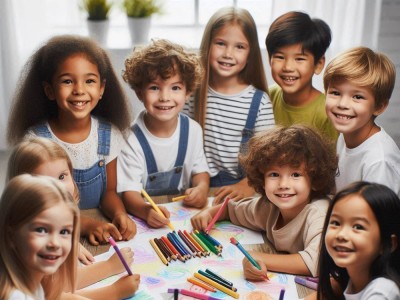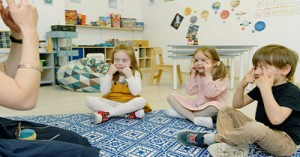Drawing is a vital activity for children's development. It helps build the foundation for writing by improving fine motor skills and hand-eye coordination and enhances planning, memory, attention span, visual perception, problem-solving, and attention to detail. The following article provides information on the Benefits Of Drawing, Why Children Draw, Encouraging Children To Draw, Linking To The EYLF and more.
Benefits Of Drawing For Children
-
Fine Motor Skills: Drawing helps children develop fine motor skills and hand-eye coordination.
-
Creativity and Imagination: It allows children to express their creativity and imagination by transforming their experiences into visual representations.
-
Pre-Writing Skills: Drawing is the foundation of pre-writing skills, helping children develop the ability to write.
-
Cognitive Development: It builds a child's attention span and cognitive understanding of concepts.
-
Problem-Solving: Drawing encourages children to solve problems creatively and gain confidence.
-
Emotional Expression: It provides an outlet for children to express their emotions and thoughts, especially for those who may not yet have the verbal skills to communicate effectively.
-
Communication Skills: Drawing nurtures the verbal skills of reading, writing, and speaking.
-
Language Development: Discussing their drawings helps children develop their vocabulary and storytelling skills.
-
Self-Esteem and Confidence: Completing a drawing can give children a sense of accomplishment and boost their self-esteem.
-
Cultural Awareness: Through drawing, children can explore and understand different cultures and perspectives.
These benefits make drawing an essential activity for children's overall development and well-being.
Why Children Draw
Children draw for a variety of reasons, and it's a crucial part of their development.
-
Self-Expression: Drawing allows children to express their thoughts, feelings, and experiences, especially when they may not yet have the verbal skills to communicate effectively.
-
Creativity and Imagination: It provides an outlet for their creativity and imagination, enabling them to create visual representations of their ideas and fantasies.
-
Emotional Outlet: Drawing can be a way for children to process and cope with their emotions, providing a safe space to explore and understand their feelings.
-
Cognitive Development: It helps develop cognitive skills such as problem-solving, planning, and understanding spatial relationships.
-
Fine Motor Skills: Drawing improves fine motor skills and hand-eye coordination, which are essential for writing and other tasks.
-
Communication: Through drawing, children can communicate their ideas and stories, enhancing their language and storytelling skills.
-
Exploration and Learning: Drawing encourages children to explore the world around them, learn about different shapes, colors, and patterns, and develop their observational skills.
Drawing is a universal activity that engages children and supports their emotional, physical, and intellectual growth.
Encouraging Children To Draw
Encouraging children to draw can be a rewarding experience that supports their development.
-
Provide Materials: Offer a variety of drawing materials such as crayons, markers, colored pencils, and paper. Having different options can spark their interest.
-
Create a Drawing Space: Set up a dedicated area for drawing where children can feel comfortable and free to create.
-
Be Supportive: Show enthusiasm for their drawings and provide positive feedback. Celebrate their efforts and creativity.
-
Join In: Draw alongside them. This can be a fun bonding activity and shows that you value drawing too.
-
Display Their Art: Hang their drawings on the fridge or a special wall. This gives them a sense of pride and accomplishment.
-
Incorporate Drawing into Daily Activities: Encourage drawing during playtime, storytelling, or even while waiting for meals. This makes it a natural part of their routine.
-
Provide Inspiration: Share books, nature, or other artworks to inspire their creativity. Sometimes seeing different styles and subjects can spark new ideas.
-
Encourage Imagination: Let them draw whatever they want without restrictions. Encourage them to use their imagination and express themselves freely.
By creating a supportive and inspiring environment, you can help children develop a love for drawing and all the benefits it brings.
Setting Up A Drawing Centre For Children
Setting up a drawing center for children can be a wonderful way to encourage creativity and artistic expression. Here are some steps to help you create an engaging and inspiring drawing center:
-
Choose a Location: Find a well-lit, comfortable space where children can sit and draw. Ensure it's free from distractions and has enough room for multiple children to work simultaneously.
-
Gather Supplies: Stock the drawing center with a variety of materials, such as:
-
Crayons, markers, colored pencils, and chalk
-
Different types of paper (plain, colored, textured)
-
Drawing boards or clipboards
-
Erasers and sharpeners
-
Stencils and rulers
-
Safe scissors and glue sticks for mixed media projects
-
-
Organize Materials: Use bins, trays, or shelves to keep supplies organized and easily accessible. Label each container to help children find what they need and encourage them to clean up after themselves.
-
Create a Display Area: Set up a space to showcase children's artwork. This could be a bulletin board, a wall, or a dedicated display table. Celebrating their creations boosts their confidence and pride in their work.
-
Incorporate Inspiration: Provide books, posters, and examples of different art styles to inspire children. You can also include nature items like leaves, flowers, and rocks for them to draw.
-
Encourage Exploration: Allow children to experiment with different materials and techniques. Encourage them to try new things and express themselves freely without worrying about making mistakes.
-
Set Guidelines: Establish simple rules to ensure the drawing center is a positive and respectful space. For example, remind children to share materials, clean up after themselves, and respect each other's artwork.
-
Provide Support: Be available to offer guidance and encouragement. Show interest in their work, ask questions about their drawings, and provide positive feedback.
How To Get Children Started With Drawing
Getting children started with drawing can be a fun and rewarding experience. Here are some tips to help you encourage their artistic journey:
-
Provide a Variety of Materials: Offer different drawing tools such as crayons, markers, colored pencils, and chalk. Having a range of options can spark their interest and creativity.
-
Create a Dedicated Drawing Space: Set up a comfortable and inviting area where children can draw freely. Ensure it's well-lit and stocked with drawing supplies.
-
Encourage Free Expression: Allow children to draw whatever they like without imposing strict guidelines. This helps them explore their creativity and express themselves.
-
Join in the Fun: Draw alongside them and show enthusiasm for their creations. This can be a great bonding activity and demonstrates that you value their artistic efforts.
-
Display Their Artwork: Hang their drawings on the fridge or a special wall. Celebrating their work boosts their confidence and pride.
-
Incorporate Drawing into Daily Activities: Encourage drawing during playtime, storytelling, or even while waiting for meals. This makes it a natural part of their routine.
-
Provide Inspiration: Share books, nature, or other artworks to inspire their creativity. Sometimes seeing different styles and subjects can spark new ideas.
-
Offer Positive Feedback: Praise their efforts and creativity, focusing on what you like about their drawings. Positive reinforcement encourages them to keep drawing.
By creating a supportive and inspiring environment, you can help children develop a love for drawing and all the benefits it brings.
Linking Drawing To The EYLF
Linking drawing to the Early Years Learning Framework (EYLF) can greatly enhance children's development across various learning outcomes. Here's how drawing can be connected to the EYLF:
-
Learning Outcome 1: Children Have a Strong Sense of Identity
-
Drawing allows children to express their individuality and creativity. They can make choices about what to draw and how to represent their ideas, which helps develop their sense of autonomy and confidence.
-
-
Learning Outcome 2: Children Are Connected with and Contribute to Their World
-
Through drawing, children can explore and represent their understanding of the world around them. They can draw their family, community, and cultural symbols, fostering a sense of belonging and respect for diversity.
-
-
Learning Outcome 3: Children Have a Strong Sense of Wellbeing
-
Drawing can be a therapeutic activity that helps children express their emotions and manage stress. It promotes mental health and well-being by providing a creative outlet for self-expression.
-
-
Learning Outcome 4: Children Are Confident and Involved Learners
-
Engaging in drawing activities encourages children to experiment with different materials and techniques, enhancing their problem-solving skills and creativity. It also helps them develop fine motor skills and hand-eye coordination.
-
-
Learning Outcome 5: Children Are Effective Communicators
-
Drawing helps children develop their communication skills by allowing them to convey their thoughts and ideas visually. It also supports language development as they describe their drawings and tell stories about them.
-
By incorporating drawing into early childhood education, educators can support children's holistic development and align with the EYLF learning outcomes.
Further Reading
Drawing And Talking In Early Writing Development
Benefits Of Art and Craft
Air Drawing Brain Breaks
Visual Motor Integration For Children
Developmental Stages Of A Child's Writing







 As an Educator in Australia, your pay rate falls under the Children’s Services Award 2010. This award states the minimum amount that an employer can
As an Educator in Australia, your pay rate falls under the Children’s Services Award 2010. This award states the minimum amount that an employer can When working as a qualified Early Childhood Teacher (with a university degree) within a service, your rate of pay will come from the Educational Services
When working as a qualified Early Childhood Teacher (with a university degree) within a service, your rate of pay will come from the Educational Services When working as a Diploma Qualified Educator your pay rate is from the Children's Services Award 2010. This Award states your minimum rate of pay
When working as a Diploma Qualified Educator your pay rate is from the Children's Services Award 2010. This Award states your minimum rate of pay When working as a Cert 3 Qualified Educator, your pay rate is from the Children's Services Award 2010. This Award states your minimum rate of
When working as a Cert 3 Qualified Educator, your pay rate is from the Children's Services Award 2010. This Award states your minimum rate of Educational Leaders play a crucial role in their early childhood service by ensuring that the educational program aligns with best practices and supports the holistic
Educational Leaders play a crucial role in their early childhood service by ensuring that the educational program aligns with best practices and supports the holistic In early childhood education and care, ratios are more than a technicality—they are a frontline safeguard. Every child deserves responsive supervision, emotional connection, and developmental
In early childhood education and care, ratios are more than a technicality—they are a frontline safeguard. Every child deserves responsive supervision, emotional connection, and developmental With the new national child safety reforms kicking in on 1 September 2025, early childhood services like yours have a real opportunity to lead the
With the new national child safety reforms kicking in on 1 September 2025, early childhood services like yours have a real opportunity to lead the Here’s a comprehensive Mobile Phone and Smart Watch Policy tailored for early childhood education and care (ECEC) services in Australia, aligned with the latest 2025
Here’s a comprehensive Mobile Phone and Smart Watch Policy tailored for early childhood education and care (ECEC) services in Australia, aligned with the latest 2025 The Sea of Fish Challenge is a national initiative that invites children, educators, families, and communities to create and display fish artworks as a symbol
The Sea of Fish Challenge is a national initiative that invites children, educators, families, and communities to create and display fish artworks as a symbol Across the early childhood education and care sector, educators are sounding the alarm: current staffing ratios are insufficient to deliver safe, meaningful, and developmentally appropriate
Across the early childhood education and care sector, educators are sounding the alarm: current staffing ratios are insufficient to deliver safe, meaningful, and developmentally appropriate


